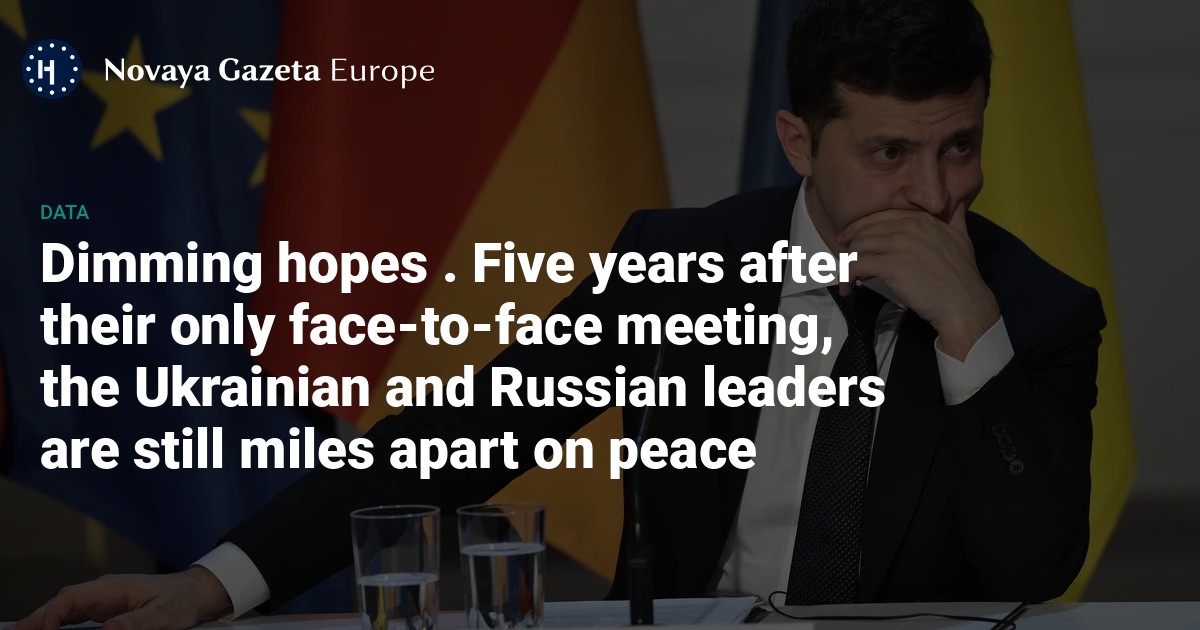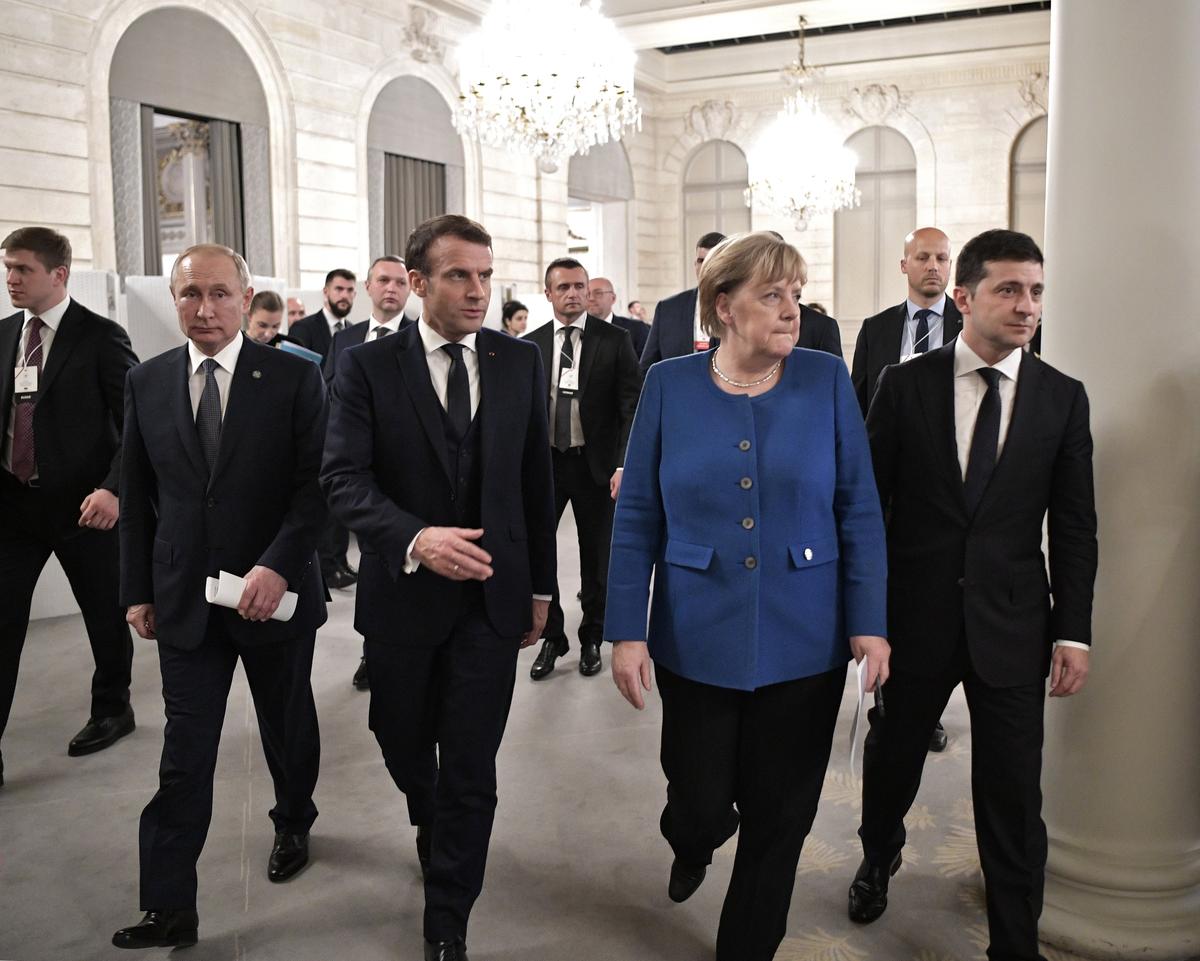



Delegations from Ukraine and Russia met for the second time in a month in Istanbul on 2 June. Missing, again, were the country’s two leaders.
For a fleeting moment ahead of the first meeting in mid-May, there existed the faintest prospect that Vladimir Putin and Ukrainian President Volodymyr Zelensky would join, sitting down in the same room for face-to-face talks.
But it didn’t happen; few expected it would. On that occasion, it was Putin who refused Zelensky’s offer of face-to-face talks in Istanbul. Even though neither leader attended the recentsummits, they have met before.
In Paris in 2019, the two men sat down together as part of what was known as the Normandy Format talks. As a scholar of international relations, I have interviewed people involved in the talks, andsome five years on, the way the talks floundered and then failed can offer lessons about the challenges today’s would-be mediators now face.
The Normandy Format talks started on the sidelines of events in June 2014 commemorating the 70th anniversary of the D-Day landings. The aim was to try to resolve the ongoing conflict between Ukrainian forces and pro-Russian separatist groups in the country’s eastern Donbas region. That conflict had recently escalated, with pro-Russian separatists seizing key towns in the Donetsk and Luhansk regions after Russia illegally annexed Crimea in February 2014.
The talks continued periodically until 2022, when Russia launched its full-scale invasion of Ukraine. Until that point, most of the discussion was framed by two deals, the Minsk accords of 2014 and 2015, which set out the terms for a ceasefire between Kyiv and the Moscow-armed rebel groups and the conditions for elections in Donetsk and Luhansk.
By the time of the sixth meeting in December 2019, the only time Zelensky and Putin have met in person, some still hoped that the Minsk accords could form a framework for peace. Zelensky, who was only a few months into his presidency, arrived in Paris with fresh energy and a desire to find peace.
By all accounts, Zelensky went into Paris believing that he could make a deal with Putin.
His electoral campaign had centred on the promise of putting an end to the unrest in Donbas, which had been rumbling on for years. The increasing role of Russia in the conflict, through supporting rebels financially and with volunteer Russian soldiers, had complicated and escalated fighting, and many Ukrainians were weary of the impact internally displaced people were causing .
By all accounts, Zelensky went into Paris believing that he could make a deal with Putin.
“I want to return with concrete results,” Zelensky said just days before meeting Putin. By then, the Ukrainian president’s only contact with Putin had been over the phone. “I want to see the person and I want to bring from Normandy understanding and feeling that everybody really wants gradually to finish this tragic war,” Zelensky said, adding, “I can feel it for sure only at the table.”
One of Putin’s main concerns going into the talks was the lifting of Western sanctions imposed in response to the annexation of Crimea.
More than anything, Russia wanted to keep Ukraine out of the European Union and NATO
But the Russian president also wanted to keep Russia’s smaller neighbour under its influence. Though Ukraine gained independence following the collapse of the Soviet Union in 1991, in the early years of the new century, Russia began to exert increasing influence over the politics of its neighbour. This ended in 2014, when a popular revolution ousted pro-Russian Ukrainian President Viktor Yanukovych and ushered in a pro-Western government.
More than anything, Russia wanted to arrest this shift and keep Ukraine out of the European Union and NATO. Those desires — Ukraine’s to end the war in Donbas, and Russia’s to curb the West’s involvement in Ukraine — formed the parameters for the Normandy talks.
And for some time, there appeared to be momentum to find compromise. French President Emmanuel Macron said that the 2019 Paris talks had broken years of stalemate and relaunched the peace process. Putin’s assessment was that the peace process was “developing in the right direction”. Zelensky’s view was a little less enthusiastic: “Let’s say for now it’s a draw.”
Yet the Putin-Zelensky meeting in 2019 ultimately ended in failure. In retrospect, both sides were talking past each other and could not reach agreement on the sequencing of key parts of the peace plan.
Zelensky wanted the security provisions of the Minsk accords, including a lasting ceasefire and the securing of Ukraine’s border with Russia, in place before proceeding with regional elections on devolving autonomy to the regions. Putin was adamant that the elections come first.
The success of the Normandy talks were also hindered by Putin’s refusal to acknowledge that Russia was a party to the conflict. Rather, he framed the Donbas conflict as a civil war between the Ukrainian government and the rebels. Russia’s role was simply to push the rebels to the negotiating table in this take — a view that was greeted with scepticism by Ukraine and the West. As a result, the Normandy talks stalled. And then in February 2022, Russia launched its full-scale invasion of Ukraine.
The nascent negotiations between Ukraine and Russia that began in Istanbul in May represent the first real attempt to bring high-level delegations of both sides together since 2019.
Many of the same challenges remain. The talks still revolve around the issues of security, the status of Donetsk and Luhansk, and prisoner exchanges — that last point being the only one in which common ground appears to be found, both in 2019 and now.
But there are major differences — not least, three years of actual direct war. Russia can no longer deny that it is party to the conflict, even if Moscow frames the war as a “special military operation” to “denazify” and demilitarise Ukraine.
Three years of war have also changed how the questions of Crimea and Donbas are framed. In the Normandy talks, there was no talk of recognising Russian control over any Ukrainian territory. But recent US efforts to negotiate peace have included a “de-jure” US recognition of Russian control in Crimea, plus “de-facto recognition” of Russia’s occupation of nearly all of Ukraine’s Luhansk region and the occupied portions of its Donetsk, Kherson and Zaporizhzhia regions.
Another major difference between the negotiation process then and now is who is mediating. The Normandy negotiations were led by German Chancellor Angela Merkel and President Emmanuel Macron of France and only Germany, France, Ukraine and Russia were involved as active participants.

Vladimir Putin (L), French President Emmanuel Macron (2-L), German Chancellor Angela Merkel (2-R) and Ukrainian President Volodymyr Zelensky (R) walk after their talks on Ukraine at the Élysée Palace Palace in Paris, France, 10 December 2019. EPA-EFE/Alexei Nikolsky/Sputnik/Kremlin Pool/Sputnik.
Today, it is the United States taking the lead, which suits Putin down to the ground, as a constant issue of the Normandy talks for him was that Germany and France were never neutral mediators.
In US President Donald Trump, Putin has found a US leader who, at least at first, appeared eager to take on the mantle from Europe. But like the Europeans involved in the Normandy talks, Trump too is encountering similar barriers to any meaningful progress.
The Istanbul negotiations on 16 May, were less productive than many people had hoped. A proposed 30-day ceasefire agreement didn’t come to fruition; instead the parties agreed on a prisoner-exchange deal. Follow-up talks on 2 June ended after barely an hour, according to Turkish officials. Again, the one point agreed on was a prisoner swap.
The Paris peace talks, too, led to a prisoner exchange — but little more. It appears that getting the leaders of Ukraine and Russia to agree on anything more ambitious is as elusive now as it was when Putin and Zelensky met in 2019.
This article was first published by The Conversation.
The Russian government has banned independent media. We were forced to leave our country in order to keep doing our job, telling our readers about what is going on Russia, Ukraine and Europe.
We will continue fighting against warfare and dictatorship. We believe that freedom of speech is the most efficient antidote against tyranny. Support us financially to help us fight for peace and freedom.
By clicking the Support button, you agree to the processing of your personal data.
To cancel a regular donation, please write to [email protected]
VPNovaya
Help Russians and Belarusians Access the Truth
